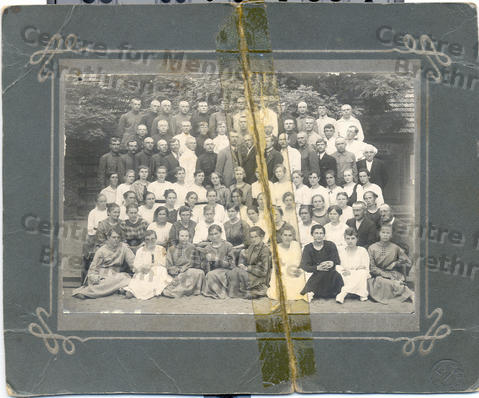ERIC KRAUSE
In
business since 1996
- © Krause House
Info-Research Solutions -
_____________________________________________________________________________________
BACKGROUND GENEALOGY
Tiegenhagen
.. As previously mentioned, 193 families [1020 people] left Prussia in 1803, stopping in the Chortiza Colony over the winter. A further 162 families [953 people] arrived from Prussia in the spring of 1804 ...
The first pioneers in 1804 founded a line of nine villages from Halbstadt to Altonau along the eastern bank of the Molochnay River. In 1805 another eight villages were laid out east of the original group, along the tributaries which flowed into the Molochnaya. In 1806 Fuerstenau was added to the northern group to complete the first burst of settlement at a total of 18 villages...
The first groups to arrive, founding the first 19 villages from 1804 to 1811 were all Flemish Mennonites. More Flemish families arrived from 1818 onward ...
VILLAGES FOUNDED BY MENNONITES IN THE MOLOTSCHNA ...
1804 .... Halbstadt ... Flemish ...
[1804] .... Muensterberg ... Flemish
[1804] ... Altonau ...... Flemish
1805 ... Tiegenhagen ... Flemish ...
[1805] Ladekopp ..... Flemish ...
[1820] Pordenau .... Frisian ...
1835 .... Gnadenfeld ... Old Flemish ...
1854 ... Kleefeld ... ----- ....
1857 ... Alexanderkrone ... ---- ...
1863 ... Klippenfeld ..... ----- ...
[Helmut T. Huebert , Hierschau: An Example of Russian Mennonite Life (Winnipeg: Kindred Press, December 1986), pp. 25, 27-29 ]
| Name | Russian name | Founded |
|---|---|---|
| 1. Halbstadt | Molotschansk | 1804 |
| 2. Neu-Halbstadt | 1804 | |
| 3. Muntau | 1804 | |
| 4. Schönau | 1804 | |
| 5. Fischau | 1804 | |
| 6. Lindenau | 1804 | |
| 7. Lichtenau | 1804 | |
| 8. Blumstein | 1804 | |
| 9. Münsterberg | 1804 | |
| 10. Altona | 1804 | |
| 11. Ladekopp | 1805 | |
| 12. Schönsee | 1805 | |
| 13. Petershagen | 1805 | |
| 14. Tiegenhagen | 1805 | |
| 15. Ohrloff | 1805 | |
| 16. Tiege | 1805 | |
| 17. Blumenort | 1805 | |
| 18. Rosenort | 1805 | |
| 19. Fürstenau | 1806 | |
| 20. Rückenau | 1811 | |
| 21. Margenau | 1819 | |
| 22. Lichtfelde | 1819 | |
| 23. Neukirch | 1819 | |
| 24. Alexandertal | 1820 | |
| 25. Schardau | 1820 | |
| 26. Pordenau | 1820 | |
| 27. Mariental | 1820 | |
| 28. Rudnerweide | 1820 | |
| 29. Grossweide | 1820 | |
| 30. Franztal | 1820 | |
| 31. Pastwa | 1820 | |
| 32. Alexanderwohl | 1820 | |
| 33. Fürstenwerder | 1821 | |
| 34. Gnadenheim | 1821 | |
| 35. Tiegerweide | 1822 | |
| 36. Liebenau | 1823 | |
| 37. Elisabethtal | 1823 | |
| 38. Wernersdorf | 1824 | |
| 39. Friedensdorf | 1824 | |
| 40. Prangenau | 1824 | |
| 41. Sparrau | 1838 | |
| 42. Konteniusfeld | 1832 | |
| 43. Gnadenfeld | 1835 | |
| 44. Waldheim | 1836 | |
| 45. Landskrone | 1839 | |
| 46. Hierschau | 1848 | |
| 47. Nikolajdorf | 1848 | |
| 48. Paulsheim | 1852 | |
| 49. Kleefeld | 1854 | |
| 50. Alexanderkrone | 1857 | |
| 51. Mariawohl | 1857 | |
| 52. Friedensruh | 1857 | |
| 53. Steinfeld | 1857 | |
| 54. Gnadental | 1862 | |
| 55. Hamberg | 1863 | |
| 56. Klippenfeld | 1863 | |
| 57. Fabrikerwiese | 1863 |
http://en.wikipedia.org/wiki/Molotschna
1914 and 1915
List of persons of the Wolost Gnadenfeld who had to surrender their weapons in accordance with Section 4 of the Decree of the Governor of Taurien ...
Tiegenhagen:
601 Braun, Johann Jacob 1 Hunting Rifle 2-barrel
602 Willms, Jacob Franz 1 Hunting Rifle 2-barrel
603 Dahl, Abram Peter 1 Hunting Rifle 2-barrel
604 Dahl, Heinrich Peter 1 Hunting Rifle
605 Ens, Abram Peter 1 Hunting Rifle 2-barrel
606 Poetker, Heinrich Jacob 1 Hunting Rifle 2-barrel
607 Martens, Heinrich Wilhelm 1 Hunting Rifle1-barrel
608 Wiebe, Bernhard Johann 1 Hunting Rifle 2-barrel
609 Rempel, Isbrandt Jacob 1 Hunting Rifle 2-barrel
610 Fast, Kornelius Kornelius 1 Hunting Rifle 2-barrel
611 Braun, Jacob Gerhard 1 Hunting Rifle 2-barrel
612 Wiebe, Johann Johann 1 Hunting Rifle 2-barrel
613 Schulz, Wilhelm Wilhelm 1 Hunting Rifle 2-barrel
614 Braun, Peter Jacob 1 Hunting Rifle 2-barrel
615 Schellenberg, Gerhard Jacob 1 Hunting Rifle1-barrel
616 Boese, Franz Peter 1 Hunting Rifle1-barrel
617 Bestvater, Johann Simon 1 Hunting Rifle1-barrel
618 Friesen, Jacob Peter 1 Hunting Rifle1-barrel
619 Kornelsen, Heinrich Jacob 1 Hunting Rifle 2-barrel
620 Community Rifle 1 Hunting Rifle 2-barrel
621 Braun, Johann Jacob 1 revolver
622 Harder, David Dietrich 1 revolver
623 Wiebe, Aron Jacob 1 revolver
624 Wiebe, Bernhard Johann 1 revolver
625 Reimer, Jacob Jacob 1 revolver
626 Wiebe, Aron Jacob 1 pistol
627 Community Rifle 2 Hunting Rifle
628 Schellenberg, Gerhard Jacob 1 pistol
629 Community Rifle
https://www.mennonitegenealogy.com/russia/Confiscated_Firearms_1914_and_1915.pdf , pp. 39, 54
[1924]

This photograph is of a large group of young men and women posing for a picture outside a building in the village of Tiegenhagen, Molotschna, south Russia. This photo may be of a [choir?] as it contains young adults and a few older adults. This photo has been damaged. It was town in two pieces from top to bottom. Repaired with clear tape on the front and cloth tape and play card in the back for reinforcement.